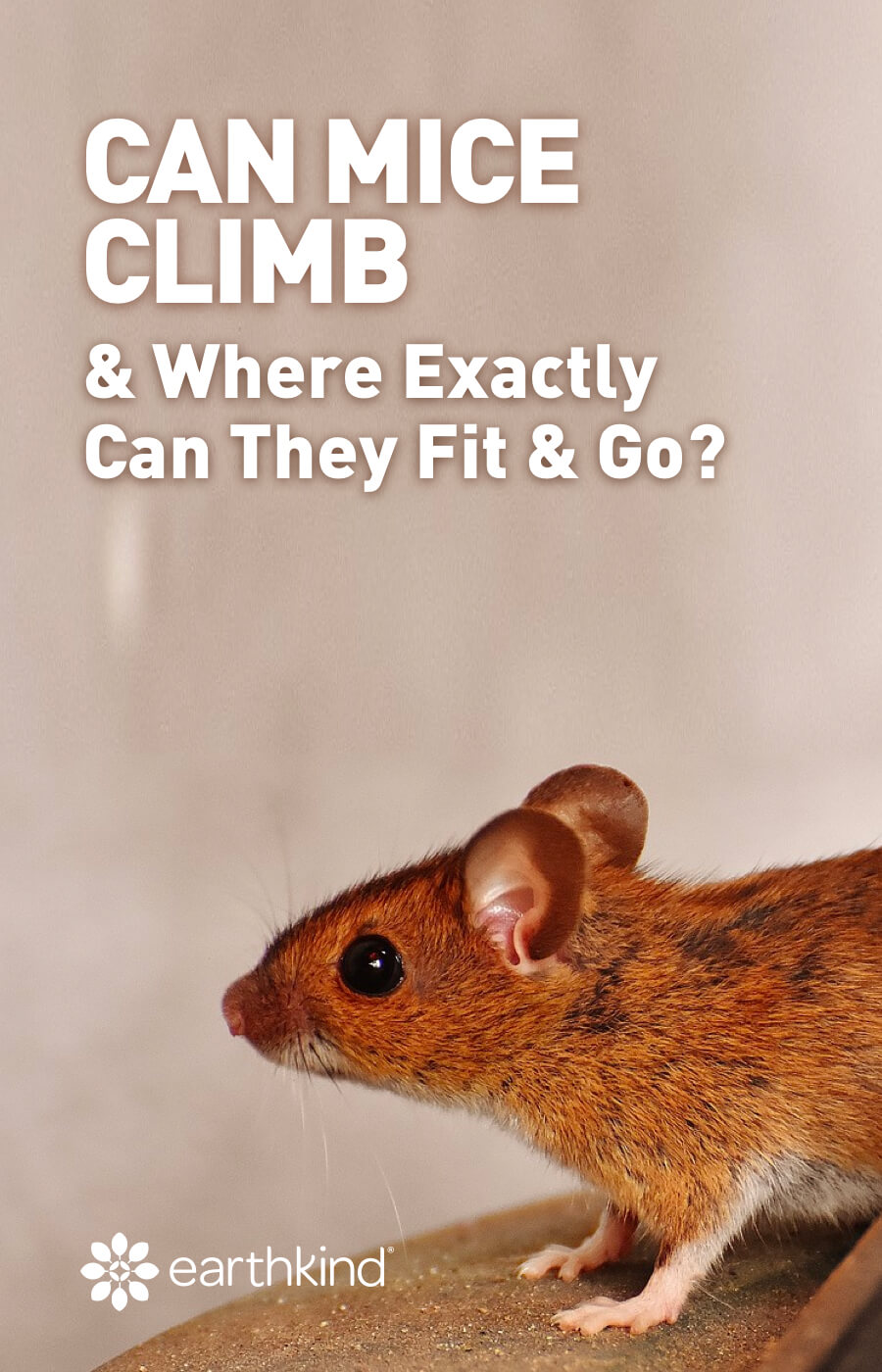Mouse Climbing Abilities & Where Exactly They Can Fit
By: EarthKind
Mice enter your home for many different reasons including safety, warmth, and food. And once they’re in, they often make their way to the darkest corners of your home like dryer vents, attics, and inside your walls.
By learning just how easily mice can climb, jump and squeeze through small holes in search of food, homeowners can better understand how to prevent them from potentially infesting their house. This is especially important since they are somewhat nocturnal and will make most of their movements when you’re sleeping.
Keep reading to learn more about their impressive abilities that help get them where they need to go.
Can Mice Climb & Jump?
Yes, mice are excellent climbers and jumpers. They can easily climb up stairs, furniture, landscape features, countertops, and even most vertical surfaces. If the interior or exterior walls have a slightly rough surface such as wood, stucco, or panels, these creatures can use their grip to make their way up. Smooth vertical surfaces don’t offer anything for mice to grip which can cause problems when trying to climb. Pipes, wires, and ropes are frequently used as travel pathways. What looks like a lovely climbing ivy to you looks like an invitation to a mouse. If they are determined to be inside your home they’ll find a way to use any crack, crevice, or rough surface to climb to get there.
These critters can easily jump distances of two feet onto surfaces like tables, countertops, and bookshelves. That’s why once you see a mouse, never assume there’s a surface they can’t reach. You’re better off cleaning all the surfaces around your house to prevent the spread of disease.
Mice don’t seem to have a fear of heights either and enjoy exploring the areas near their nest. They travel and climb surfaces for a few reasons:
- To search for food
- Looking for nesting materials
- Escape danger like a predator (or house cat).
Although mice can climb into your bed or scale kitchen countertops, they actually want to avoid humans at all costs and are only looking to fulfill a basic need like finding food or shelter.
It’s difficult to know exactly how or when these pests enter your living space because they can chew through your drywall and fit through the tiniest crevices without you knowing. But if you’re curious how they made their way all the way up to your attic – they jumped and climbed!
Keep your home pest free with simple, effective solutions. Subscribe and save!
Do Mice Have Bones?
Yes, mice have bones. No, mouse skeletons don’t “collapse,” they are just very small and effective home invaders. An average house mouse is between five and eight inches long (including tail) and weighs only an ounce or less. A mouse’s skull is the biggest part of its body; if its head can fit through an opening, the rest of the body will fit as well. Unlike humans, they have a sloping clavicle, or collarbone, which makes squeezing through small spaces easy.
Their whiskers can sense if there is enough space for the rest of the body to follow. That’s one reason they always go nose first instead of backing up in reverse. They rely on their sense of touch and smell to navigate tricky spaces.
How Small of a Hole Can They Fit Through?
Mice are so flexible, they can squeeze through an opening that is just the size of a pencil. Keep that in mind and do an inspection of your home to find potential entry points. Gaps along the edges of doors or openings for plumbing and utility lines offer an easy way in for these critters. Inspecting the outside of your home at night, with all of the lights on inside may make it easier to notice small openings because you will see light shining through.
Mice also enter homes, buildings, and other structures through the roof. Dryer vents, chimneys, and HVAC conduits can all provide easy access for rodents into your home. Block potential entry points with silicone caulk, steel wool, wire mesh, or hardware cloth.
Knowing the small spaces they can use to enter a home will make it easier for you to find and assess mouse problems and infestations.
Keep Them Away
If you don’t like the thought of mice climbing, jumping, and squeezing into small spaces around your home, it’s important to take steps towards prevention. Sealing up any holes that can be an entry point for a pest, eliminating food sources and clutter that could entice them, and using a botanical repellent are all pest control methods that could help.









 day
day
Hi, can mice climb into your toilet?
Like from the ground into your toilet?
We saw a mouse in our bathroom two days ago, and today we found one dead in the toilet… is is possible it’s the same mouse?
Hi Megan,
This is a sad but true reality, but rodents can enter your home through sewer lines and toilets. Keeping the lid down is always a good idea, along with protecting your home with a few pouches of botanical rodent repellent.
Thanks for reading!
i saw a mouse literally jump into my closet as soon as I turned around in my chair, I got my cat and it started sniffing but didn’t find anything however it did look up where to mouse could’ve climbed up to the top shelf.(Which is about 1 1/2 metres in the air. How ever there are clothes which reach only about 5-15 cm off the ground im guessing it could’ve climbed up of. It was a very small brownish mouse. and i’ve spend a couple hours looking for it. Im’ not sure where it is coming from, however we do keep our garage door open most times, so our cat can have some outside time to herself.
Please Help.
I have a mouse and it has been in every room but there are no mouse droppings to indicate there is a mouse. I know I have a mouse because I have seen it in every room. I don’t know where its coming from and I don’t want to kill it what can I get to chase it out of my house. I am not scared of mice I don’t even hear it making any noise. Can you help. I live in England.
Hi Marian,
I’m sorry to hear about the mouse in your house! Unfortunately, our products are not available for international sale, but you can still get rid of mice without killing them. Many people have reported success using essential oils to get rid of mice. Our main ingredient is balsam fir oil, but some people also report success with peppermint oil. If you make your own repellent with essential oils, you will have to check them frequently to make sure the scent hasn’t worn off. Sometimes rodents will use the cotton balls (or whatever carrier material you use) to make nests after the scent of the oils has evaporated. The other things you can do yourself to prevent mice include storing all food (even pet food and bird seed) in air tight containers that mice can’t chew through and using a trash bin with a tight fitting lid. Inspect your home for small openings they may be using to get inside and block them with steel wool and silicone caulk.
Thanks for reading!
I’ve seen comments here and there that mice can jump about 2 feet with ease. My bed is probably about 2 1/2. Do you think they could jump onto my bed?
Also. I think they like it in my closet. I’ve seen a mouse run in and out of the closet a few times.
Hi Carina,
Mice are excellent jumpers and climbers, so it’s possible they would be able to get onto your bed even if it is about 2 1/2 feet above the floor. Closets are popular places for mice, since it’s an area you probably don’t spend much time in — it is easy for pests to hide there without being noticed.
Try our 3 step plan to get rid of mice and stop them from coming back: 1) Clean up – Remove clutter mice might use to nest in such as piles of clothing, cardboard boxes, or seldom used items; 2) Seal up – look for any holes, cracks or gaps mice might use to get inside such along baseboards or electric outlets; 3) Pouch up – place pouches of EarthKind’s botanical rodent repellent in areas where you’ve seen mice activity. The scent from the pouches will repel mice for at least 30 days.
Thanks for reading!
Hi can they climb up cling film? Trying to stop one getting in my birds cage. Thanks
Hi Vanessa,
I suspect the answer is yes. Mice have sharp nails on their paws that would probably shred the cling film. Keeping mice away from bird feed can be very challenging. If you haven’t already, make sure to store any food you’re not currently using in an airtight chew-proof container to prevent mice from getting it, and clean the area around the cage frequently. You can try using our botanical rodent repellent pouches in the area to make the mice stay away, but keep an eye on your bird for any changes in behavior since birds can be especially sensitive to essential oils.
Thanks for reading!